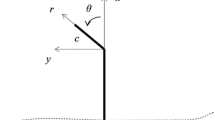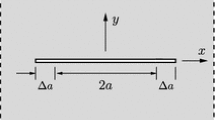Abstract
This chapter presents a survey of non-linear fracture mechanics of inhomogeneous quasi-brittle material. The large scale bridging in the fracture process zone is explicitly modelled as cohesive spring-like tractions and its implications on crack formation and limitations of linear elastic fracture mechanics are discussed. A model of tension-softening is described to illustrate the possibility of relating the micromechanical mechanisms and the material structure to composite non-linear fracture property. Finally, recent research on experimental determination of tension-softening behavior in inhomogeneous quasi-brittle materials is reviewed.
Access this chapter
Tax calculation will be finalised at checkout
Purchases are for personal use only
Preview
Unable to display preview. Download preview PDF.
Similar content being viewed by others
References
Diamond, S. and A. Bentur: On the Cracking in Concrete and Fiber Reinforced Cements, in: Application of Fracture Mechanics to Cementitious Composites (Ed. S.P. Shah ), Martinus Nijhoff Publ., 1985, 87–140.
Li, V.C., S. Backer, Y. Wang, R. Ward, and E. Green: Toughened Behavior and Mechanisms of Synthetic Fiber Reinforced Normal Strength and High Strength Concrete, in: Fiber Reinforced Cements and Concretes, Recent Developments (Eds. R.N. Swamy and B. Barr), Elsevier Applied Science, London, 1989, 420–433.
Mandell, J., Darwish, and F. McGarry: Fracture testing of injection-molded glass and carbon fiber-reinforced thermoplastics, ASTM STP 734 (1981), 73–90.
Jang and Liu: Fracture behavior of short-fiber reinforced thermoplastics, I: crack propagation mode and fracture toughness, J. Appl. Poly. Sci., (1985), 3925–3942.
Becher, P.F., C.H. Hsueh, P. Angelini, and T.N. Tiegs: Toughening behavior in whisker-reinforced ceramic matrix composites, J. Am. Soc., 71, 12 (1988), 10501061.
Ruhle, M., B.J. Dalgleish, and A.G. Evans: On the toughening of ceramics by whisker, Scrip. Metal., 21 (1987), 681–686.
Evans, A.: The New High Toughness Ceramics, SB report, 87.
Mindess, S.: The Application of Fracture Mechanics to Cement and Concrete: A Historical Review, in: Fracture Mechanics of Concrete (Ed. F.H. Wittmann ), Elsevier Publ., 1983, 1–30.
Swanson, P.L.: Crack-interface Traction: A Fracture-Resistance Mechanism in Brittle Polycrystals, in: Advances in Ceramics, Am. Ceram. Soc., Columbus, OH, 1986.
Swanson, P.L., C.J. Fairbanks, B.R. Lawn, Y.W. Mai, and B.J. Hockey: Crack-interface grain bridging as a fracture resistance mechanism in ceramics: I, experimental study on alumina, J. Am. Ceram. Soc., 70, 4 (1987), 279–289.
Sakai, M., J. I. Yoshimura, Y. Goto, and M. Inagaki: R-Curve behavior of a polycrystalline graphite: microcracking and grain bridging in the wake region, J. Am. Ceramic Soc., 71, 8 (1988), 609–616.
Reichl, A. and R.W. Steinbrech: Determination of crack-bridging forces in alumina, J. Am. Ceram. Soc., 71, 6 (1988), 299–301.
Kramer, E.J.: Microscopic and Molecular Fundamentals of Crazing, in: Crazing in Polymers, Advances in Polymer Science 52/53, (Ed. H.H. Kausch ), Springer-Verlag, 1983, 1–56.
Budiansky, B.: Micromechanics II, in: Proceedings of Tenth U.S. Congress of Applied Mechanics, 1986.
Rose, L.R.F.: Crack reinforcement by distributed springs, J. Mech. Phys. Sol., 35 (1987), 383–405.
Marshall, D.B., and A.G. Evans: The influence of residual stress on the toughness of reinforced brittle materials, Material Forum, 11 (1988), 304–312.
Rice, J. R.: Mathematical Analysis in the Mechanics of Fracture, in: Fracture: An Advanced Treatise, 2, Academic Press, (1968), 191–311.
Rose, L.R.F.: Toughening due to crack-front interaction with a second-phase dispersion, Mech. of Mat., 6 (1987), 11–15.
Rice, J. R.: Crack Fronts Trapped By Arrays of Obstacles: Solutions Based on Linear Perturbation Theory, in: Analytical, Numerical, and Experimental Aspects of Three Dimensional Fracture Processes, AMD-91, (Eds. A.J. Rosakis, K. Ravi-Chandar, Y. Rajapakse ), ASME, 1988, 175–184.
Irwin, G.R.: Analysis of stresses and strains near the end of a crack traversing a plate, J. Applied Mechanics, 24 (1957), 361–364.
Barenblatt, G.I.: Mathematical Theory of Equilibrium Cracks in Brittle Fracture, in: Advances in Applied Mechanics, VII, Academic Press, New York, 1962.
Dugdale, D.S.: Yielding of steel sheets containing slits, J. Mechanics and Physics of Solids, V. 8, 1960.
Marshall, D.B. and B.N. Cox: A J-Integral method for calculating steady-state matrix cracking stresses in composites, Mechanics of Materials, 7 (1988), 127–133.
Li, V.C. and E. Liang:. Fracture process in concrete and fiber reinforced cementitious composites, ASCE J. of Engineering Mechanics, 112, 6 (1986), 566–586.
Palmer, A.C. and J.R. Rice: The Growth of Slip-Surfaces in the Progressive Failure of Overconsolidated Clay Slopes, Proceedings of the Royal Society of London, A332, (1973), 572–548.
Leung, C.K., and V.C. Li: Reliability of First-Cracking Strength for Short-fiber Reinforced Brittle Matrix Composites, In: Ceramics Eng. Sci. Proc., 9/10, 1989, 11641178.
Marshall, D.B. and A.G. Evans: Tensile Strength of Uniaxially Reinforced Ceramic Fiber Composites, in: Fracture Mechanics of Ceramics, (Eds. R.C. Bradt, A.G. Evans, D.P.H. Hasselman and F.F. Lange), 7, Plenum Press, New York (1986), 1–15.
Hillerborg, A., M. Modeer, and P.E. Petersson: analysis of crack formation and crack growth in concrete by means of fracture mechanics and finite elements, Cement and Concrete Research, 6, (1976), 773–782.
Ingraffea, A. and W.H. Gerstle: Nonlinear Fracture Models for Discrete Crack Propagation, in: Applications of Fracture Mechanics to Cementitious Composites, NATO ASI Series, 94 ( Ed. S.P. Shah) Martinus Nijhoff Publ., 1985, 247–286.
Ingraffea, A.: Theory of Crack Initiation and Propagation in Rock, in: Fracture Mechanics of Rock, (Ed. B. Atkinson ), Academic Press, 1987, 71–110.
Mai, Y. and B. Lawn: Crack-interface grain bridging as a fracture resistance mechanism in ceramics: ii theoretical fracture mechanics model, J. Am. Ceram. Soc. 70, 4 (1987), 289–294.
Swanson, P.L.: Tensile fracture resistance mechanisms in brittle polycrystals: an ultrasonics and in-situ microscopy investigation, J. Geophysical Res., 92, (1987), 8015–8036.
Wecharatana, M. and S.P. Shah: Slow crack growth in cement composites, J. Stru., ASCE, 108, 6, (1982), 1400–1413.
Cook, R.: Transient Fracture Resistance in the Weak Toughening Limit, in: International Congress of Fracture, Proceeding Vol. 4, (Eds. Salama, Ravi-Chandar, Taplin, and Rao ), 1989, 2747–2756.
Francois, D.: Fracture and Damage Mechanics of Concrete, in: Application of Fracture Mechanics to Cementitious Composites, (Ed. S.P. Shah) Martinus Nijhoff Publ., 1985, 141–156.
Takahashi, H. and H. Abé: Fracture Mechanics Applied to Hot, Dry Rock Geothermal Energy, in: Fracture Mechanics of Rock, (Ed. B. Atkinson ), Academic Press, 1987, 241–276.
Ingraffea, A.R., K.L.Gaunsallus, J.F. Beech and P.P. Nelson: A Short Rod Based System for Fracture Toughness Testing of Rock, in: Chevron-Notched Specimens: Testing and Stress Analysis, ASTM STP 855, Louisville, (1983), 152–166.
Li, V. C., K. Chong, and H. H. Einstein, Tension Softening and Size Effects on Fracture Toughness Determination of Geomaterials, in: Fracture of Concrete and Rock, (Eds. Swartz and S. Shah), Springer-Verlag, New York, 255–264, 1989.
Li, V.C.: Mechanics of Shear Rupture Applied to Earthquake Zones, in Fracture Mechanics of Rock, (Ed. B.K. Atkinson ), Academic Press, 1987, 351–432.
Bazant, Z.P., S. Sener and P.C. Prat: Fracture Mechanics Size Effect and Ultimate Load of Beams Under Torsion, in: Application of Fracture Mechanics to Concrete, Ed. V.C. Li and Z. Bazant, ACI STP, 1990, 171–178.
Wang, Y., V.0 Li, and S. Backer: Tensile failure mechanisms in synthetic fiber reinforced mortar, submitted to the J. Materials Science (1990).
Li, V.C., Y. Wang, and S. Backer: A statistical-micromechanical model of tension-softening behavior of short fiber reinforced brittle matrix composites, submitted for publication, J. Mech. and Phys. of Solids (1990).
Li, V.C., Y. Wang, and S. Backer: Effect of inclining angle, bundling, and surface treatment on synthetic fiber pull-out from a cement matrix, to appear in Composites (1990).
Greszczuk, L. B.: Theoretical studies of the mechanics of the fiber-matrix interface in composites, in ASTM STP 452 (1969), 42–58.
Takaku, A. and R.G.C. Arridge: The effect of interfacial radial and shear stress on fiber pull-out in composite materials, Journal of Physics D: Applied Physics, 6 (1973), 2038–2047.
Lawrence, P.: Some theoretical considerations of fiber pull out from an elastic matrix, J. Mat.Sci. 7, (1972) 1–6.
Gopalaratnam, V.S., and S.P. Shah: Tensile failure of steel fiber-reinforced mortar, ASCE J. of Engineering Mechanics, 113, 5, (1987), 635–652.
Wang, Y., V.0 Li, and S. Backer: Modeling of fiber pull-out from a cement matrix, International J. of Cement Composites and lightweight Concrete, 10, 3, (1988), 143149.
Wang, Y., V.C. Li, and S. Backer: Analysis of synthetic fiber pull-out from a cement matrix, Material Research Society Symposium Proceeding, 114, (1988), 159–165.
Naaman, A., and S.P. Shah: Pull-out mechanism in steel fiber reinforced concrete, J. Struc., ASCE, 102, ST8, (1976), 1537–1548.
Wang, Y., V.C. Li, and S. Backer: Experimental determination of tensile behavior of fiber reinforced concrete, to appear in ACI Materials Journal (1990).
Wang, Y., V.C. Li, and S. Backer: Tensile properties of synthetic fiber reinforced mortar, to appear in J. of Cement Composites and Lightweight Concrete (1990).
Li, V.C., and E. Green: Tensile behavior of synthetic fiber reinforced high strength mortar and concrete, in preparation (1990).
Wang, Y., S. Backer, and V.C. Li: An experimental study of synthetic fiber reinforced cementitious composites, Journal of Materials Science, 22, (1987), 4281–4291.
Wang, Y., S. Backer, and V.C. Li: A special technique for determining the critical length of fiber pull-out from a cement matrix, J. of Materials Science Letters, 7 (1988), 842–844.
Li, V.C., Y. Wang and S. Backer: Effect of Fiber-Matrix Bond Strength on The Crack Resistance of Synthetic Fiber Reinforced Cementitious Composites, in: Bonding in Cementitious Composites (Eds. S. Mindess and S. Shah), MRS Symposia 114: 1988, 167–174.
Visalvanich K. and A.E. Naaman: In: Fracture Mechanics Methods for Ceramics, Rocks, and Concrete, ASTM STP 745, (Ed.S.W. Freiman and E.R. Fuller) 1981, 141156.
Visalvanich, K. A.E. Naaman: Fracture Model for fiber reinforced concrete, ACI J. March-April, 1983, 128–138.
Petersson, P.E.: Crack Growth And Development Of Fracture Zone In Plain Concrete And Similar Materials. Div. of Building Materials, Lund Institute of Technology, Sweden. Report TVBM-1006, 1981.
Reinhardt, H.W.: Fracture Mechanics Of An Elastic Softening Material Like Concrete, Heron, Delft University of Technology, 29: 2, 1984.
Marshall, D.B. and A.C. Evans: Failure mechanisms in ceramic-fiber/ceramic matrix composites, J. Am. Ceram. Soc., 68, 5 (1985) 225–31.
Gopalaratnam, V.S. and S.P. Shah,. Softening response of concrete in direct tension, J. Amer. Concrete Inst. 82: 310 (1985).
Labuz, J.F., S.P. Shah and C. H. Dowding: Measurement and description of the tensile fracture process in rock, ASCE J. Eng. Mech., (1989).
Li, V.C.: Fracture Resistance Parameters For Cementitious Materials And Their Experimental Determination, in: Application of Fracture Mechanics to Cementitious Composites, (Ed. S.P. Shah) Martinus Nijhoff Publ., 1985, 431–452.
Li, V.C., C.M. Chan, and C.K.Y. Leung: Experimental determination of the tension softening relations for cementitious composites, Cement and Concrete Research, 17 (1987) 441–452.
Leung, C.K.Y. and V.C. Li: Determination of fracture toughness parameter of quasi-brittle materials with laboratory-size specimens, J. of Materials Science, 24, (1989) 854–862.
Li, V.C. and R. Ward: A Novel Testing Technique for Post-Peak Tensile Behavior of Cementitious Materials, in: Fracture Toughness and Fracture Energy - Test Methods for Concrete and Rock, (Ed. Mihashi), in press, A.A.Balkema Publishers, Netherlands, 1989.
Chong, K.P., V.C. Li and H. Einstein: Size effects, process zone, and tension softening behavior in fracture of geomaterials“, in press, Int’l J. of Engineering Fracture Mechanics, 1989.
Chong, K.P., K.D. Basham, and D.Q. Wang: Fracture parameters derived from tension-softening measurements using semi-circular specimens, in: Fracture Toughness and Fracture Energy - Test Methods for Concrete and Rock, (Ed. Mihashi), in press, A.A.Balkema Publishers, Netherlands, 1989.
Hashida, T.: Tension-softening curve measurements for fracture toughness determination in granite, in: Fracture Toughness and Fracture Energy - Test Methods for Concrete and Rock, (Ed. Mihashi), in press, A.A.Balkema Publishers, Netherlands, 1989.
Rice, J.R.: A path independent integral and the approximate analysis of strain concentrations by notches and cracks, J. Applied Mechanics, 35 (1968) 379–386.
Reyes, O.M.L.: Numerical Modelling Of Fracture Propagation In Tension Softening Materials, M.S. Thesis, MIT, Cambridge, MA, (1987).
Author information
Authors and Affiliations
Editor information
Editors and Affiliations
Rights and permissions
Copyright information
© 1990 Springer-Verlag Wien
About this chapter
Cite this chapter
Li, V.C. (1990). Non-Linear Fracture Mechanics of Inhomogeneous Quasi-Brittle Materials. In: Wnuk, M.P. (eds) Nonlinear Fracture Mechanics. International Centre for Mechanical Sciences, vol 314. Springer, Vienna. https://doi.org/10.1007/978-3-7091-2758-2_4
Download citation
DOI: https://doi.org/10.1007/978-3-7091-2758-2_4
Publisher Name: Springer, Vienna
Print ISBN: 978-3-211-82246-3
Online ISBN: 978-3-7091-2758-2
eBook Packages: Springer Book Archive




